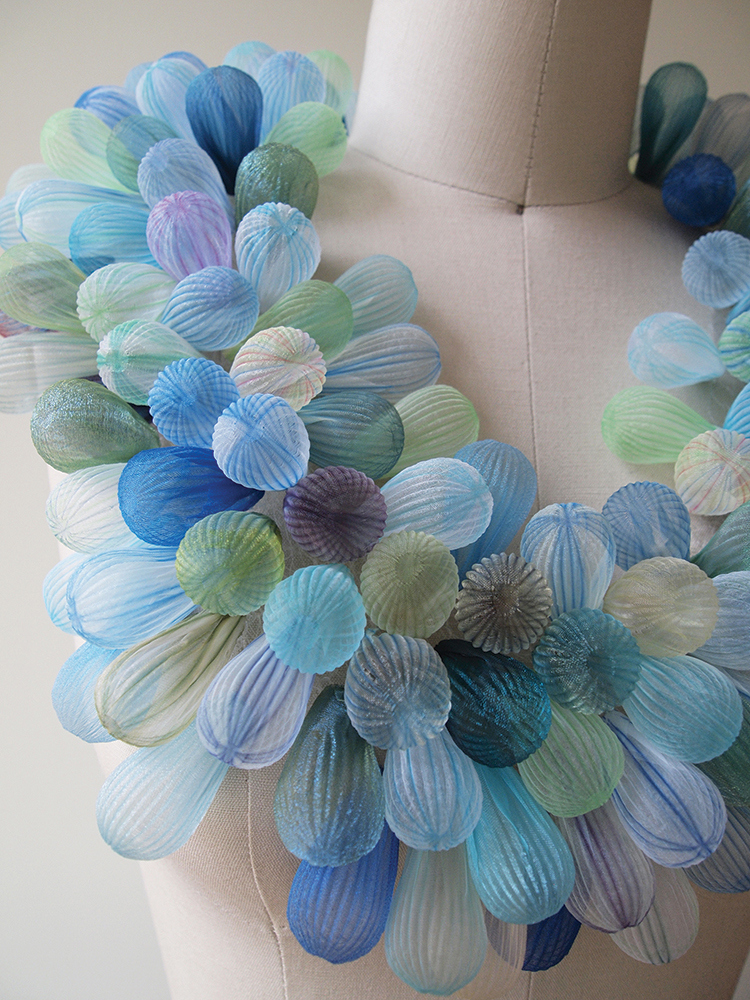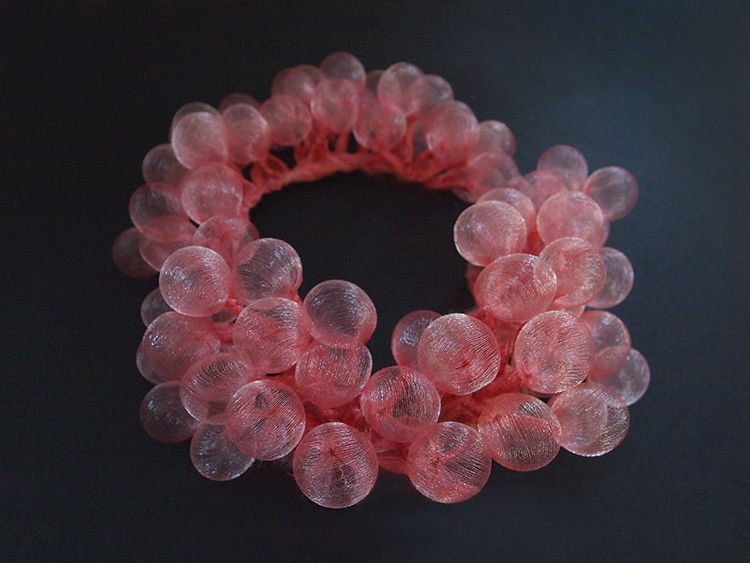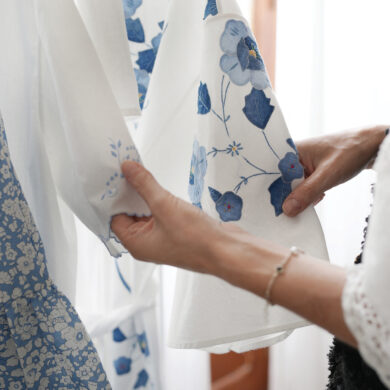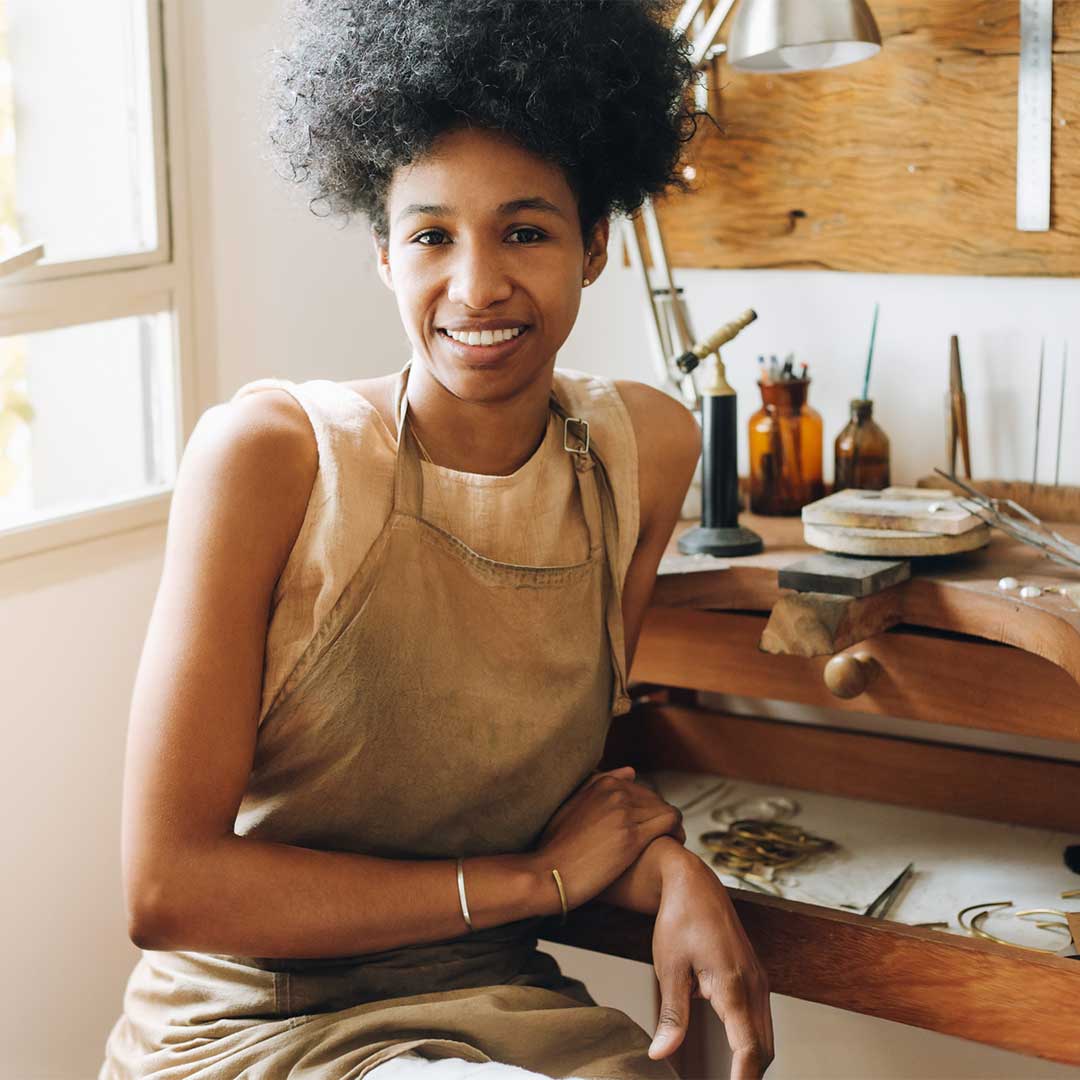
I became determined to be a professional artist while still in my early teens, and I attended a high school in Japan that offered an art major with a broad range of studio and liberal arts studies. In junior high school, I attend sewing classes, where I initially experienced the enjoyment of working with fabric. In order to be accepted into an art college, my education was reinforced by attending a rigorous college preparatory “cramming” program (gakushu juku) following my regular school day. My combined studies were intense and highly focused and were bolstered by my discipline.
While at art college, I received a well-rounded education in a variety of art disciplines, including drawing, painting, printmaking, and metalworking. Shortly after completing my undergraduate studies, I moved to the USA to continue my education, eventually settling here.

Growing up in Japan and living in the USA for 30 years has exposed me to both the western and Japanese aesthetics, which enhanced my curiosity and have broadened my view. I am able to appreciate all art forms (architecture, graphic design, sculpture, etc.), and I regard them all as one. To me, there is no boundary between the different categories.
When I entered art college in Japan, my major was oil painting. At the beginning of my junior year, I was able to choose between either an oil painting or printmaking major, so I decided to switch to printmaking with a focus on metal-etching.
Metal has been a familiar material to me since I was a child. Growing up in a Buddhist temple that was founded 400 years ago, I was always surrounded by the beauty of nature and ancient things, like the faded paint on wood and stone steps with hollows created by centuries of raindrops dripping off the roof. I was also fascinated by the elaborate metal and wood ornaments made by skilled craftsmen that were throughout the temple; polishing the ornaments in the altars was one of my chores. So I was always interested in metal.

In college, I learned photo-etching techniques, and I found myself more fascinated by the metal than by the images printed on the paper. After I took a small metal sculpture class, I began making three-dimensional metal sculptures using photo-etching techniques. After that, I worked with metal for about 18 years.
Metal construction had been my main focus since 1995, but in 2013, after completing a very involved and technically challenging metal piece, I felt the need to move away from using purely representational imagery. I wanted to do something more abstract and organic and with a different material. The result has been my fabric work.
Fabric is the complete opposite of metal. I like the softness and gentle texture of the fabric I use, as well as the atmospheric nature of its translucency. The full potential of what I can do with fabric is still unknown to me. I’m on a journey to explore the endless, unlimited possibilities of this material.
My sculptures begin by my being inspired by nature and the material itself, in addition to my being motivated by the process. Almost half of my creative time is spent experimenting. During the experimental process, there is sometimes a breathtaking moment. I pay attention to these accidental discoveries, capture those moments, and develop new ideas from that point.
Great ideas often come to me but thinking about ideas and working with the actual materials are very different experiences. I make lots of discoveries while working on pieces that I never would have thought of in advance.

Whenever I’m working on something, it often opens up new doors that drive apiece in a whole new direction, revealing more possibilities. I always feel like the possibilities are endless,and ideas keep expanding. I already have so many ideas and have discovered so many things that I probably won’t be able to make them all while I’m still alive.
I’m inspired by and learn from nature directly. For example, one day, I found a very beautiful brain coral at a flea market. Because I was so fascinated by it, I learned how it was structured and recreated it with fabric. Nature is the best teacher.
I’m interested in sea creatures, plants, the microscopic world, diatom, cells, etc. I’m always fascinated by systematically formed shapes and moved by the wonder of nature.
I especially love sea creatures; they are artwork by themselves, and I’m always blown away by their beauty. Whenever I have the opportunity, I enjoy watching documentary films about the deep ocean. I’m constantly amazed by creatures that I’ve never seen before.

There are so many creatures that haven’t been discovered yet. The ocean is full of mysteries.

I also enjoy the element of ambiguity that tends to be built into much of my work. My intention with the fabric pieces is not just to mimic nature or the natural world, but rather to communicate the perceived sensory experience of encountering the subject in nature.
Besides being inspired by nature, I am also inspired by the material itself. Encountering different types of material in daily life is important to me. Sometimes, I’ll come across a material that I find mesmerizing, and it will draw me in and stir my imagination.
Fabric is one of the most familiar of everyday materials. Even though the word “fabric” sounds straightforward enough, the range of different fabrics is broad, with unique characteristics that can draw out a variety of sensations or emotions. Some fabrics imply the cool feeling of moisture, others have a fluffiness that is comforting; there are fabrics that invoke the mysterious or the ethereal; there are fabrics that inspire tranquility; and some fabrics suggest fragility, subtlety, etc.

The textile materials that I like to use are synthetic fiber, such as polyester and nylon. They can memorize shapes when they are heated, and I love that characteristic. The main difficulty is the softness of fabric. Working with jewelry sizes is not so hard, and I’m able to manipulate the fabric the way I want to most of the time. However, I also make larger-scale fabric sculptures, which is challenging because of the nature of soft material. To retain the shapes, I need to think about how to support them.
I also develop fabric pieces that reflect my strong interest in the material itself. Fabric is inherently the opposite of metal, the material I previously worked with exclusively for many years. I strive to bring out the fabric’s inherent characteristics and beauty. By using a proprietary heat-setting technique, I give it a new identity through reshaping it into three-dimensional forms.
Because I love the translucency of fabric, through working with layers and adding or moving parts, I can create playful, mysterious, and ethereal atmospheres.

My work reflects various, observable phenomena that stimulate my mind and senses; they can be natural or man-made. I ‘reorganize’ them into a new presentation that can be described as surreal, amusing, graceful, or unexpected. A playful, happy atmosphere pervades my work. I always like to leave some space for the viewer’s imagination; I hope the viewer experiences discovery, surprise, and wonder through my work.

As a matter of fact, ordinarily, I don’t wear jewelry, but one day I was walking through the crowd at a big art opening event wearing my big brooch. As people walked by me, so many of them gazed at my brooch and started asking me a lot of questions and showed admiration. I was very much surprised by the power of wearable art.
I often hear from people who purchased my work, “Many people react to the piece, and I get lots of compliments!” My pieces are made out of mostly polyester, but at first glance, sometimes it’s hard to know what the material is and how I created it because of the way I choose and manipulate the materials. My pieces look mysterious sometimes. People often say, “what is it???” and then a conversation begins.

That convinced me that wearable art is a tool for communication between the wearer, the artist, and the viewers. At the same time, it is also a conversation just between the artist and the wearer. The wearer purchases a piece if the artwork resonates in their heart and, by wearing it, expresses something that is part of them. In other words, it’s a collaboration between the wearer and artist.
Wearable art can be a device for expressing one’s individuality, character, personality, etc. It also opens up the question of what the wearable art means to the wearer. By wearing it, the owner is forced to consider what the piece means to them.
Wearable art can affect the wearer’s emotions. I get comments from people saying how my pieces make them feel lighthearted, positive, uplifted, happy, etc. You cannot wear large paintings and sculptures. Because of the smaller scale, there are things that only contemporary jewelry can achieve, and this is an interesting thing about it.
It’s hard to say who influenced me the most. I’m influenced by many artists from different fields.
This wide, deep perspective has been reinforced by a solid educational background, providing me with knowledge and understanding of many different kinds of materials. My mind is very flexible, I have discipline, and my creativity is not restricted by any rules.
I think that having my work included in the permanent collections of renowned museums is the most meaningful thing for me as an artist, more than anything else. It is a great honor.
Currently, I’m getting ready for a solo exhibition at the Morikami Museum in Florida, U.S., scheduled for 2023. I will be showing both sculptural and wearable fabric pieces.
Working in a larger scale is a challenge for me, but it may also open up new doors. I believe it will take me in new directions.


I became determined to be a professional artist while still in my early teens, and I attended a high school in Japan that offered an art major with a broad range of studio and liberal arts studies. In junior high school, I attend sewing classes, where I initially experienced the enjoyment of working with fabric. In order to be accepted into an art college, my education was reinforced by attending a rigorous college preparatory “cramming” program (gakushu juku) following my regular school day. My combined studies were intense and highly focused and were bolstered by my discipline.
While at art college, I received a well-rounded education in a variety of art disciplines, including drawing, painting, printmaking, and metalworking. Shortly after completing my undergraduate studies, I moved to the USA to continue my education, eventually settling here.

Growing up in Japan and living in the USA for 30 years has exposed me to both the western and Japanese aesthetics, which enhanced my curiosity and have broadened my view. I am able to appreciate all art forms (architecture, graphic design, sculpture, etc.), and I regard them all as one. To me, there is no boundary between the different categories.
When I entered art college in Japan, my major was oil painting. At the beginning of my junior year, I was able to choose between either an oil painting or printmaking major, so I decided to switch to printmaking with a focus on metal-etching.
Metal has been a familiar material to me since I was a child. Growing up in a Buddhist temple that was founded 400 years ago, I was always surrounded by the beauty of nature and ancient things, like the faded paint on wood and stone steps with hollows created by centuries of raindrops dripping off the roof. I was also fascinated by the elaborate metal and wood ornaments made by skilled craftsmen that were throughout the temple; polishing the ornaments in the altars was one of my chores. So I was always interested in metal.

In college, I learned photo-etching techniques, and I found myself more fascinated by the metal than by the images printed on the paper. After I took a small metal sculpture class, I began making three-dimensional metal sculptures using photo-etching techniques. After that, I worked with metal for about 18 years.
Metal construction had been my main focus since 1995, but in 2013, after completing a very involved and technically challenging metal piece, I felt the need to move away from using purely representational imagery. I wanted to do something more abstract and organic and with a different material. The result has been my fabric work.
Fabric is the complete opposite of metal. I like the softness and gentle texture of the fabric I use, as well as the atmospheric nature of its translucency. The full potential of what I can do with fabric is still unknown to me. I’m on a journey to explore the endless, unlimited possibilities of this material.
My sculptures begin by my being inspired by nature and the material itself, in addition to my being motivated by the process. Almost half of my creative time is spent experimenting. During the experimental process, there is sometimes a breathtaking moment. I pay attention to these accidental discoveries, capture those moments, and develop new ideas from that point.
Great ideas often come to me but thinking about ideas and working with the actual materials are very different experiences. I make lots of discoveries while working on pieces that I never would have thought of in advance.

Whenever I’m working on something, it often opens up new doors that drive apiece in a whole new direction, revealing more possibilities. I always feel like the possibilities are endless,and ideas keep expanding. I already have so many ideas and have discovered so many things that I probably won’t be able to make them all while I’m still alive.
I’m inspired by and learn from nature directly. For example, one day, I found a very beautiful brain coral at a flea market. Because I was so fascinated by it, I learned how it was structured and recreated it with fabric. Nature is the best teacher.
I’m interested in sea creatures, plants, the microscopic world, diatom, cells, etc. I’m always fascinated by systematically formed shapes and moved by the wonder of nature.
I especially love sea creatures; they are artwork by themselves, and I’m always blown away by their beauty. Whenever I have the opportunity, I enjoy watching documentary films about the deep ocean. I’m constantly amazed by creatures that I’ve never seen before.

There are so many creatures that haven’t been discovered yet. The ocean is full of mysteries.

I also enjoy the element of ambiguity that tends to be built into much of my work. My intention with the fabric pieces is not just to mimic nature or the natural world, but rather to communicate the perceived sensory experience of encountering the subject in nature.
Besides being inspired by nature, I am also inspired by the material itself. Encountering different types of material in daily life is important to me. Sometimes, I’ll come across a material that I find mesmerizing, and it will draw me in and stir my imagination.
Fabric is one of the most familiar of everyday materials. Even though the word “fabric” sounds straightforward enough, the range of different fabrics is broad, with unique characteristics that can draw out a variety of sensations or emotions. Some fabrics imply the cool feeling of moisture, others have a fluffiness that is comforting; there are fabrics that invoke the mysterious or the ethereal; there are fabrics that inspire tranquility; and some fabrics suggest fragility, subtlety, etc.

The textile materials that I like to use are synthetic fiber, such as polyester and nylon. They can memorize shapes when they are heated, and I love that characteristic. The main difficulty is the softness of fabric. Working with jewelry sizes is not so hard, and I’m able to manipulate the fabric the way I want to most of the time. However, I also make larger-scale fabric sculptures, which is challenging because of the nature of soft material. To retain the shapes, I need to think about how to support them.
I also develop fabric pieces that reflect my strong interest in the material itself. Fabric is inherently the opposite of metal, the material I previously worked with exclusively for many years. I strive to bring out the fabric’s inherent characteristics and beauty. By using a proprietary heat-setting technique, I give it a new identity through reshaping it into three-dimensional forms.
Because I love the translucency of fabric, through working with layers and adding or moving parts, I can create playful, mysterious, and ethereal atmospheres.

My work reflects various, observable phenomena that stimulate my mind and senses; they can be natural or man-made. I ‘reorganize’ them into a new presentation that can be described as surreal, amusing, graceful, or unexpected. A playful, happy atmosphere pervades my work. I always like to leave some space for the viewer’s imagination; I hope the viewer experiences discovery, surprise, and wonder through my work.

As a matter of fact, ordinarily, I don’t wear jewelry, but one day I was walking through the crowd at a big art opening event wearing my big brooch. As people walked by me, so many of them gazed at my brooch and started asking me a lot of questions and showed admiration. I was very much surprised by the power of wearable art.
I often hear from people who purchased my work, “Many people react to the piece, and I get lots of compliments!” My pieces are made out of mostly polyester, but at first glance, sometimes it’s hard to know what the material is and how I created it because of the way I choose and manipulate the materials. My pieces look mysterious sometimes. People often say, “what is it???” and then a conversation begins.

That convinced me that wearable art is a tool for communication between the wearer, the artist, and the viewers. At the same time, it is also a conversation just between the artist and the wearer. The wearer purchases a piece if the artwork resonates in their heart and, by wearing it, expresses something that is part of them. In other words, it’s a collaboration between the wearer and artist.
Wearable art can be a device for expressing one’s individuality, character, personality, etc. It also opens up the question of what the wearable art means to the wearer. By wearing it, the owner is forced to consider what the piece means to them.
Wearable art can affect the wearer’s emotions. I get comments from people saying how my pieces make them feel lighthearted, positive, uplifted, happy, etc. You cannot wear large paintings and sculptures. Because of the smaller scale, there are things that only contemporary jewelry can achieve, and this is an interesting thing about it.
It’s hard to say who influenced me the most. I’m influenced by many artists from different fields.
This wide, deep perspective has been reinforced by a solid educational background, providing me with knowledge and understanding of many different kinds of materials. My mind is very flexible, I have discipline, and my creativity is not restricted by any rules.
I think that having my work included in the permanent collections of renowned museums is the most meaningful thing for me as an artist, more than anything else. It is a great honor.
Currently, I’m getting ready for a solo exhibition at the Morikami Museum in Florida, U.S., scheduled for 2023. I will be showing both sculptural and wearable fabric pieces.
Working in a larger scale is a challenge for me, but it may also open up new doors. I believe it will take me in new directions.























